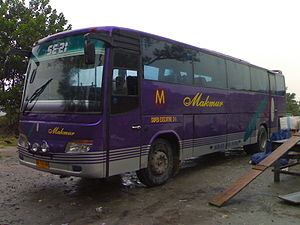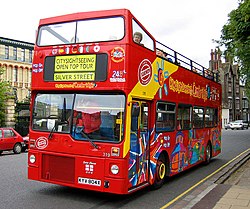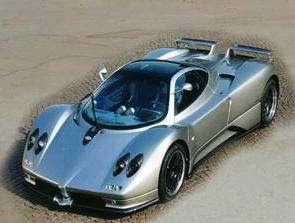Power steering
From Wikipedia, the free encyclopedia
The term
power steering is usually used to describe a system that provides mechanical
steering assistance to the driver of a land vehicle, for example, a car or truck. The power steering system in a vehicle is a type of
servomechanism.
For many drivers, turning the steering wheel in a vehicle that doesn't have power steering requires more force (
torque) than the driver finds comfortable, especially when the vehicle is moving at a very slow speed. Steering force is very sensitive to the weight of the vehicle, and nearly so much to its length, so this is most important for large vehicles. In a vehicle equipped with power steering, when the driver turns the steering wheel, he feels only a slight retarding force, so a vehicle equipped with power steering can be driven by any healthy driver, even when the vehicle is being parked. This is because the power steering system furnishes most of the energy required to turn the steered wheels of the car.
Most power steering systems in cars and light trucks today are hydraulic (that is, the force to turn the wheels is provided by a hydraulic piston, which is powered by high pressure hydraulic fluid), but in some cars and trucks, the steering force is provided by an electric motor.
| www.compAGbagus.blogspot.com |
[edit] History
A steam-powered ship's
steering engine, similar in many ways to the power steering system used in modern cars and trucks, was first installed in the
SS Great Eastern in 1866.
The earliest known patent for a power steering system for a land vehicle was granted to Frederick W. Lanchester in the UK in February 1902.
[citation needed] His invention was to "cause the steering mechanism to be actuated by hydraulic power".
[citation needed] R.E. Twyford included a mechanical power steering mechanism as part of his patent for the first four wheel drive system (U.S. Patent 646,477 April 3, 1900). The next design was filed as recorded by the US Patent Office on August 30, 1932, by Klara Gailis, from Belmont, Massachusetts.
[citation needed] There is another inventor credited with the invention of power steering by the name of Charles F. Hammond an American, born in Detroit, who filed similar patents, the first of which was filed as recorded by the Canadian Intellectual Property Office.
[citation needed]
Francis W. Davis, an engineer of the truck division of
Pierce Arrow began exploring how steering could be made easier, and in 1926 demonstrated the first power steering system.
[1] Davis moved to
General Motors and refined the hydraulic-assisted power steering system, but the automaker calculated it would be too expensive to produce.
[2] Davis then signed up with
Bendix, a parts manufacturer for automakers. Military needs during
World War II for easier steering on heavy vehicles boosted the need for power assistance on
armored cars and tank-recovery vehicles for the British and American armies.
[2]
Chrysler Corporation introduced the first commercially available passenger car power steering system on the 1951
Chrysler Imperial under the name "Hydraguide".
[3] The Chrysler system was based on some of Davis' expired patents.
General Motors introduced the 1952
Cadillac with a power steering system using the work Davis had done for the company almost twenty years earlier.
[4]
Most new vehicles now have power steering, owing to the trends toward front wheel drive, greater vehicle mass, and wider
tires, which all increase the required steering effort. Heavier vehicles as common in some countries would be extremely difficult to maneuver at low speeds, while vehicles of lighter weight may not need power assisted steering at all.
[edit] Hydraulic systems

A power steering fluid reservoir and pulley driven pump
Most power steering systems work by using a
hydraulic system to turn the vehicle's wheels. The hydraulic pressure is usually provided by a
gerotor or
rotary vane pump driven by the vehicle's engine. A double-acting
hydraulic cylinder applies a
force to the steering gear, which in turn applies a
torque to the steering axis of the roadwheels. The flow to the cylinder is controlled by
valves operated by the steering wheel; the more torque the driver applies to the steering wheel and the shaft it is attached to, the more fluid the valves allow through to the cylinder, and so the more force is applied to steer the wheels in the appropriate direction.
One design for measuring the torque applied to the steering wheel is to fix a
torsion bar to the end of the steering shaft. As the steering wheel rotates, so does the attached steering shaft, and so does the top end of the attached torsion bar. Since the torsion bar is relatively thin and flexible and the bottom end is not completely free to rotate, the bar will soak up some of the torque; the bottom end will not rotate as far as the top end. The difference in rotation between the top and bottom ends of the torsion bar can be used to control the valve that allows fluid to flow to the cylinder which provides steering assistance; the greater the "twist" of the torsion bar, the more steering assistance will be provided.
Since the pumps employed are of the positive displacement type, the flow rate they deliver is directly proportional to the speed of the engine. This means that at high engine speeds the steering would naturally operate faster than at low engine speeds. Because this would be undesirable, a restricting orifice and flow control valve are used to direct some of the pump's output back to the hydraulic reservoir at high engine speeds. A pressure relief valve is also used to prevent a dangerous build-up of pressure when the hydraulic cylinder's piston reaches the end of the cylinder.
Some modern implementations also include an electronic pressure relief valve which can reduce the hydraulic pressure in the power steering lines as the vehicle's speed increases (this is known as variable assist power steering).
Some heavy machines use hydraulic-only systems where there is no backup if the pump motor fails.
[edit] DIRAVI
In the
DIRAVI system invented by
Citroën, the force turning the wheels comes from the car's high pressure hydraulic system and is always the same no matter what the road speed is. As the steering wheel is turned, the wheels are turned simultaneously to a corresponding angle by a hydraulic
piston. In order to give some artificial steering feel, there is a separate hydraulically operated system that tries to turn the steering wheel back to centre position. The amount of pressure applied is proportional to road speed, so that at low speeds the steering is very light, and at high speeds it is very difficult to move more than a small amount from the centre position.
As long as there is pressure in the car's hydraulic system, there is no mechanical connection between the steering wheel and the roadwheels. This system was first introduced in the
Citroën SM in 1970, and was known as 'VariPower' in the UK and 'SpeedFeel' in the U.S.
While DIRAVI is not the mechanical template for all modern power steering arrangements, it did innovate the now common benefit of
speed sensitive steering. The force of the centering device increases as the car's road speed increases.
In the late 1960s, General Motors offered a variable ratio power steering system as an option on Pontiac and other vehicles.
[edit] Electro-hydraulic systems
Electro-hydraulic power steering systems, sometimes abbreviated EHPS, and also sometimes called "hybrid" systems, use the same hydraulic assist technology as standard systems, but the hydraulic pressure is provided by a pump driven by an
electric motor instead of being belt-driven by the engine.
In 1965, Ford experimented with a fleet of "wrist-twist instant steering" equipped
Mercury Park Lanes that replaced the conventional large steering wheel with two 5-inch (127 mm) rings, a fast 15:1 gear ratio, and an electric hydraulic pump in case the engine stalled.
[5][6]
In 1994 Volkswagen produced the Mark 3 Golf Ecomatic, which utilized an electric pump so that the power steering could operate while the engine had been turned off by the computer to save fuel.
[7] Electro-hydraulic systems can be found in some cars by
Ford,
Volkswagen,
Audi,
Peugeot,
Citroen,
SEAT,
Skoda,
Suzuki,
Opel,
MINI,
Toyota,
Honda, and
Mazda.
[edit] Servotronic
Servotronic offers true
speed-dependent power steering, in which the amount of
servo assist depends on road speed, and thus provides even more comfort for the driver. The amount of power assist is greatest at low speeds, for example when parking the car. The greater assist makes it easier to maneuver the car. At higher speeds, an electronic sensing system gradually reduces the level of power assist. In this way, the driver can control the car even more precisely than with conventional power steering. Servotronic is used by a number of automakers, including
Audi,
General Motors,
BMW,
Volkswagen,
Volvo,
SEAT and
Porsche. Servotronic is a trademark of AM General Corp.
[8]
[edit] Electric systems
Electric power steering (
EPS or
EPAS) is designed to use an
electric motor to reduce effort by providing steering assist to the
driver of a
vehicle. Sensors detect the motion and
torque of the steering column, and a computer module applies assistive torque via an electric motor coupled directly to either the steering gear or steering column. This allows varying amounts of assistance to be applied depending on driving conditions. The system allows engineers to tailor steering-gear response to variable-rate and variable-damping suspension systems achieving an ideal blend of ride, handling, and steering for each vehicle.
[9] On Fiat group cars the amount of assistance can be regulated using a button named "CITY" that switches between two different assist curves, while most other EPS systems have variable assist, which allows for more assistance as the speed of a vehicle decreases and less assistance from the system during high-speed situations. In the event of component failure, a mechanical linkage such as a
rack and pinion serves as a back-up in a manner similar to that of hydraulic systems. Electric power steering should not be confused with
drive-by-wire or steer-by-wire systems which use electric motors for steering, but without any mechanical linkage to the steering wheel.
Electric systems have a slight advantage in
fuel efficiency because there is no belt-driven hydraulic pump constantly running, whether assistance is required or not, and this is a major reason for their introduction. Another major advantage is the elimination of a belt-driven engine accessory, and several high-pressure hydraulic hoses between the hydraulic pump, mounted on the engine, and the steering gear, mounted on the chassis. This greatly simplifies manufacturing and maintenance. By incorporating
electronic stability control electric power steering systems can instantly vary torque assist levels to aid the driver in evasive manoeuvres.
The first electric power steering systems appeared on the
Honda NSX in 1990, the
FIAT Punto Mk2 in 1999, the
Honda S2000 in 1999, and on the
BMW Z4[10] in 2002. Today a number of manufacturers use electric power steering.
Reviews in the automotive press often comment that certain steering systems with electric assist do not have a satisfactory amount of "road feel". Road feel refers to the relationship between the force needed to steer the vehicle and the force that the driver exerts on the steering wheel. Road feel gives the driver the subjective perception that they are engaged in steering the vehicle. The amount of road feel is controlled by the computer module that operates the electric power steering system. In theory, the software should be able to adjust the amount of road feel to satisfy drivers. In practice, it has been difficult to reconcile various design constraints while producing a more pronounced road feel
[citation needed]. The same argument has been applied to hydraulic power steering as well.
[edit] Variable gear ratios
In 2000, Honda launched the
S2000 Type V equipped with the world's first electric power variable
gear ratio steering (VGS) system.
[11][12] In 2002, Toyota introduced their own "Variable Gear Ratio Steering (VGRS)" system introduced on the
Lexus LX 470 and Landcruiser Cygnus, and also incorporated the
electronic stability control system to alter steering gear ratios and steering assist levels. In 2003, BMW introduced their "
Active Steering" system on the
5-series.
[13]
This system should not be confused with variable assist power steering which varies steering assist torque not steering ratios, nor with systems where the gear ratio is only varied as a function of steering angle.



















 Selamat datang di Blog PO. Harapan Jaya. Disini anda dapat temukan segala informasi tentang layanan jasa tranportasi Bus PO. Harapan Jaya
Selamat datang di Blog PO. Harapan Jaya. Disini anda dapat temukan segala informasi tentang layanan jasa tranportasi Bus PO. Harapan Jaya
















.JPG)




